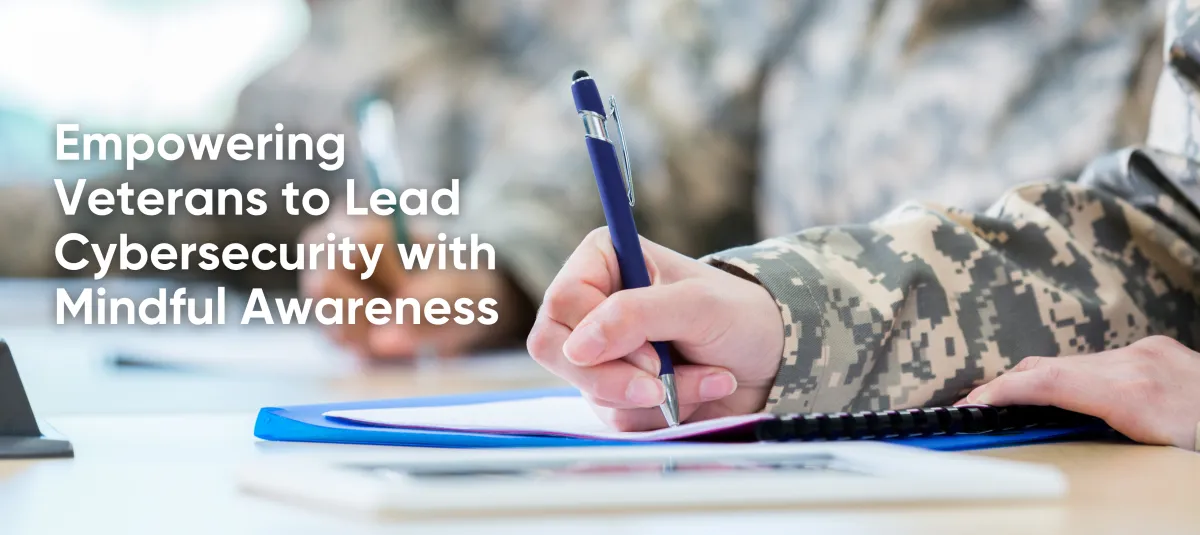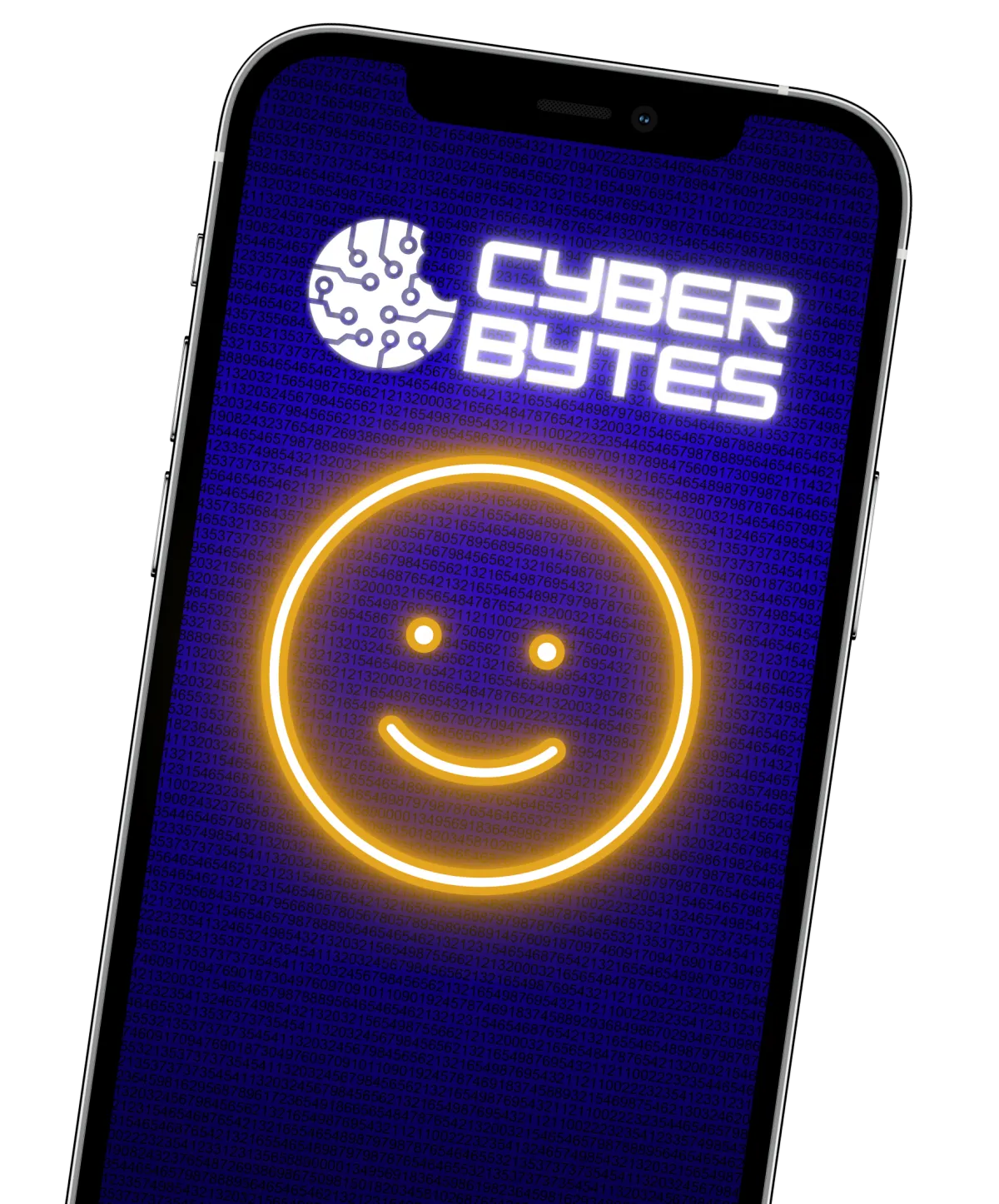You are what you click!
Learn how to make cybersecurity your way of life in an easy and guided way.
You are what you click!
Become Cyber savvy
EXPLORE BLOG BELOW
You are what you click!
Become Cyber savvy
You are what you click!
Become Cyber savvy
You are what you click!
Become Cyber savvy

Empowering Veterans to Lead Cybersecurity with Mindful Awareness
The digital landscape is ever-evolving, and the significance of cybersecurity within this landscape cannot be overstated. Here is where the stature of veterans comes into sharp relief, as they bring their unmatched discipline and strategic insight to the forefront of digital defense. Many veterans channel the discipline, strategic acumen, and tenacity they honed in the military into the civilian sector. There is one domain where these traits are not only welcome but essential: cybersecurity!
Because the digital frontier is our modern battleground, who better to navigate this terrain than those who’ve valiantly stood on the front lines of our nation’s defense? Yet, in this transition lies an unexpected ally – mindfulness – the practice of being Intentional, Aware, and Mindful (Be I AM). Far from being mere buzzwords or serene pastimes, mindfulness serves as a tool for empowerment and a catalyst for effective cybersecurity leadership. Let’s explore more.
Mindful Intention:
The Veteran’s Compass in Cybersecurity Intention is the compass that guides a cybersecurity professional. For veterans moving into the sphere of digital defense, intentionality means a deliberate and purposeful approach to every facet of cybersecurity. They are not just reacting to threats; they are anticipating them, devising strategic defenses with the same precision once dedicated to military missions.
For instance, imagine Sarah, an Air Force veteran, who applies her strategic training to crafting cybersecurity protocols. When her company faces a data breach, her intentionality comes to the fore. She leads her team not just to patch vulnerabilities but to revamp their threat assessment model—transforming a crisis into a turning point for lasting improvement.

Awareness:
The Clear Lens of the Veteran Mind Situational awareness in the military is about comprehending one’s environment amidst chaos. In cybersecurity, awareness is equally critical, where threats are invisible and constantly evolving. For example, imagine veterans like Michael, a former intelligence officer, leverage their heightened awareness to pinpoint anomalies in network traffic that may indicate a breach, vigilantly safeguarding the digital environment they now protect.
We urge our readers, veterans and non-veterans to cultivate this element of awareness in their everyday digital practices. Keep abreast of the latest cyber threats, and be ever-watchful for signs of phishing, fraud, and scams in your online engagements.
Mindfulness:
Mindfulness in leadership is the stable hand guiding the helm, especially in the turbulent seas of cyber threats. It entails leading with a presence that is both calming and commanding. Veterans understand this profoundly, having experienced high-stake situations where lives depended on their mental clarity and composure.
The Mindful Cyber Warrior’s Toolkit
While the concept may appear abstract, there are practical ways to embed mindfulness into cybersecurity:
Meditative Analysis: Adopting a meditative approach to data analysis, focusing intently on the task at hand, acknowledging but not engaging with distractions.
Breathwork in Decision Making: Using controlled breathing to maintain calm during high-pressure situations, ensuring decisions are made with a cool head.
Mindful Communication: Practicing fully present engagement with team members, promoting an atmosphere of clear, concise, and effective dialogue.
These tools not only benefit the individual; they amplify the entire team’s effectiveness, creating a culture of mindfulness that seeps into every aspect of cybersecurity operations.
Begin with simple daily exercises such as deep breathing to center your thoughts prior to engaging in cybersecurity tasks. This practice sharpens focus and maintains equanimity, essential for informed decision-making in the dynamic landscape of cyber technology.

Empowerment Over Fear:
Our goal is to empower, not to instill fear. Cybersecurity, when guided by mindful leadership, becomes less about the fear of potential threats and more about the power of preparedness. Veterans are uniquely equipped to lead in this regard, demonstrating courage in the face of adversity.
Engage with communities to exchange insights and learn from the personal cybersecurity experiences of others. Connect with veterans who are leading in cybersecurity and draw from the wisdom of their experiences. As we strengthen our digital defenses, let’s look to the seasoned expertise of our veterans, and arm them with the Be I AM principle. They bring a blend of intention, awareness, and mindfulness to cybersecurity, elevating it from a technical challenge to a human triumph.
Together, we build not just technical safeguards but also resilience and preparedness. We integrate mindfulness into our cyber defenses, ensuring that veterans lead with clarity and insight, securing not only our data but also our confidence in the technology that connects and defines our world.
Let us be intentional in our cybersecurity strategies, aware of our surroundings, and mindful in our actions. This path leads to a secure and resilient digital future, shepherded by veterans who serve with an unwavering spirit. Thank you all for your service!

FAQ’s
How does mindfulness enhance the leadership of veterans in the field of cybersecurity?
Mindfulness enhances veterans’ cybersecurity leadership by strengthening crucial skills like focus, situational awareness, stress resilience, and communication. Practices like breathwork and meditation help veterans stay present and alert when facing cyber threats. This allows them to guide teams and develop strategies with clarity even amid chaos.
Can you explain the practical applications of mindfulness as a tool for veterans in cybersecurity leadership?
Some practical applications include starting meetings with 1-2 minutes of mindful breathing, doing quick body scans before high-stakes decisions to reduce stress, and scheduling micro-meditations between meetings to refresh focus. Veterans can also set daily intentions each morning to cultivate calm, compassionate leadership. Mindfully assessing situations before reacting also helps veterans respond thoughtfully as cyber leaders.
What are the key benefits of empowering veterans to lead cybersecurity with mindful awareness?
Key benefits include optimized human performance, less reactivity, proactive threat response, resonant leadership, compassion for colleagues, and the ability to inspire a mindful cyberculture. With mindfulness, veterans lead from a place of inner stillness, wisdom and expanded perspective. This human-centric leadership is exactly what the field needs.
In what ways does mindfulness play a role in promoting effective cybersecurity leadership among veterans?
Mindfulness promotes effective cyber leadership by enhancing focus, situational awareness, stress management, and communication. It allows veterans to tap into intuition and think holistically. By modeling mindful practices, veterans inspire others to cultivate mindfulness as well, collectively strengthening organizational cyber resilience.
How does mindful leadership empower veterans to excel in cybersecurity, and where can veterans access resources to develop these skills?
Mindful leadership empowers veterans by unlocking their natural talents for focus, service and technical acumen. Resources include mindfulness training programs for cyber operators, veteran peer groups focused on mindfulness, conferences on mindful security, and writings by veterans experienced in mindfulness practices. With these resources, veterans can fulfill their potential as visionary cyber leaders.
What tips can you share for veteran cyber leaders communicating mindful practices to colleagues skeptical of the benefits?
Lead by example, embodying mindfulness principles like focus and compassion. Share personal anecdotes of how mindfulness has helped your work. Start with 5-10 minutes of activities before meetings so colleagues experience benefits first-hand. Encourage curiosity and voluntary participation. Collect data on mindfulness impacts at work. Bolster credibility by citing studies on mindfulness and cyber performance. Patience and persistence are key.
What role does mindfulness play in managing the emotional and mental challenges that come with cybersecurity threats?
Mindfulness is pivotal in managing the emotional and mental challenges in cybersecurity, as it equips veterans with tools to mitigate stress and anxiety. This can be critical in high-stress situations like responding to security breaches or persistent threats, where clear-headedness is essential.
Can mindfulness impact the ethical decision-making required in cybersecurity? How so?
Indeed, mindfulness can positively impact ethical decision-making in cybersecurity. It encourages a pause for reflection, enabling veterans to consider the broader implications of their actions and choose solutions that align with ethical standards and organizational values.
How can mindfulness training be integrated into ongoing professional development for cybersecurity teams?
Cyber Mindfulness training can be integrated into professional development through regular workshops, integration into daily team meetings, and by providing access to resources such as mindfulness tools and in-house ‘mindful moments’ that encourage brief periods of reflection and stress reduction throughout the workday. I’m excited to launch the first Cybersecurity and Mindfulness training. Inner Cyber will be available for you and your teams. To learn more contact us at [email protected] or join our newsletter so you don’t miss our announcements of Inner Cyber!

Live Happily Ever Cyber!

Sandra Estok
Subscribe for more ways to protect what matters most to you against hackers, scammers, and Cybermonsters™
Latest blog posts:

Empowering Veterans to Lead Cybersecurity with Mindful Awareness
The digital landscape is ever-evolving, and the significance of cybersecurity within this landscape cannot be overstated. Here is where the stature of veterans comes into sharp relief, as they bring their unmatched discipline and strategic insight to the forefront of digital defense. Many veterans channel the discipline, strategic acumen, and tenacity they honed in the military into the civilian sector. There is one domain where these traits are not only welcome but essential: cybersecurity!
Because the digital frontier is our modern battleground, who better to navigate this terrain than those who’ve valiantly stood on the front lines of our nation’s defense? Yet, in this transition lies an unexpected ally – mindfulness – the practice of being Intentional, Aware, and Mindful (Be I AM). Far from being mere buzzwords or serene pastimes, mindfulness serves as a tool for empowerment and a catalyst for effective cybersecurity leadership. Let’s explore more.
Mindful Intention:
The Veteran’s Compass in Cybersecurity Intention is the compass that guides a cybersecurity professional. For veterans moving into the sphere of digital defense, intentionality means a deliberate and purposeful approach to every facet of cybersecurity. They are not just reacting to threats; they are anticipating them, devising strategic defenses with the same precision once dedicated to military missions.
For instance, imagine Sarah, an Air Force veteran, who applies her strategic training to crafting cybersecurity protocols. When her company faces a data breach, her intentionality comes to the fore. She leads her team not just to patch vulnerabilities but to revamp their threat assessment model—transforming a crisis into a turning point for lasting improvement.

Awareness:
The Clear Lens of the Veteran Mind Situational awareness in the military is about comprehending one’s environment amidst chaos. In cybersecurity, awareness is equally critical, where threats are invisible and constantly evolving. For example, imagine veterans like Michael, a former intelligence officer, leverage their heightened awareness to pinpoint anomalies in network traffic that may indicate a breach, vigilantly safeguarding the digital environment they now protect.
We urge our readers, veterans and non-veterans to cultivate this element of awareness in their everyday digital practices. Keep abreast of the latest cyber threats, and be ever-watchful for signs of phishing, fraud, and scams in your online engagements.
Mindfulness:
Mindfulness in leadership is the stable hand guiding the helm, especially in the turbulent seas of cyber threats. It entails leading with a presence that is both calming and commanding. Veterans understand this profoundly, having experienced high-stake situations where lives depended on their mental clarity and composure.
The Mindful Cyber Warrior’s Toolkit
While the concept may appear abstract, there are practical ways to embed mindfulness into cybersecurity:
Meditative Analysis: Adopting a meditative approach to data analysis, focusing intently on the task at hand, acknowledging but not engaging with distractions.
Breathwork in Decision Making: Using controlled breathing to maintain calm during high-pressure situations, ensuring decisions are made with a cool head.
Mindful Communication: Practicing fully present engagement with team members, promoting an atmosphere of clear, concise, and effective dialogue.
These tools not only benefit the individual; they amplify the entire team’s effectiveness, creating a culture of mindfulness that seeps into every aspect of cybersecurity operations.
Begin with simple daily exercises such as deep breathing to center your thoughts prior to engaging in cybersecurity tasks. This practice sharpens focus and maintains equanimity, essential for informed decision-making in the dynamic landscape of cyber technology.

Empowerment Over Fear:
Our goal is to empower, not to instill fear. Cybersecurity, when guided by mindful leadership, becomes less about the fear of potential threats and more about the power of preparedness. Veterans are uniquely equipped to lead in this regard, demonstrating courage in the face of adversity.
Engage with communities to exchange insights and learn from the personal cybersecurity experiences of others. Connect with veterans who are leading in cybersecurity and draw from the wisdom of their experiences. As we strengthen our digital defenses, let’s look to the seasoned expertise of our veterans, and arm them with the Be I AM principle. They bring a blend of intention, awareness, and mindfulness to cybersecurity, elevating it from a technical challenge to a human triumph.
Together, we build not just technical safeguards but also resilience and preparedness. We integrate mindfulness into our cyber defenses, ensuring that veterans lead with clarity and insight, securing not only our data but also our confidence in the technology that connects and defines our world.
Let us be intentional in our cybersecurity strategies, aware of our surroundings, and mindful in our actions. This path leads to a secure and resilient digital future, shepherded by veterans who serve with an unwavering spirit. Thank you all for your service!

FAQ’s
How does mindfulness enhance the leadership of veterans in the field of cybersecurity?
Mindfulness enhances veterans’ cybersecurity leadership by strengthening crucial skills like focus, situational awareness, stress resilience, and communication. Practices like breathwork and meditation help veterans stay present and alert when facing cyber threats. This allows them to guide teams and develop strategies with clarity even amid chaos.
Can you explain the practical applications of mindfulness as a tool for veterans in cybersecurity leadership?
Some practical applications include starting meetings with 1-2 minutes of mindful breathing, doing quick body scans before high-stakes decisions to reduce stress, and scheduling micro-meditations between meetings to refresh focus. Veterans can also set daily intentions each morning to cultivate calm, compassionate leadership. Mindfully assessing situations before reacting also helps veterans respond thoughtfully as cyber leaders.
What are the key benefits of empowering veterans to lead cybersecurity with mindful awareness?
Key benefits include optimized human performance, less reactivity, proactive threat response, resonant leadership, compassion for colleagues, and the ability to inspire a mindful cyberculture. With mindfulness, veterans lead from a place of inner stillness, wisdom and expanded perspective. This human-centric leadership is exactly what the field needs.
In what ways does mindfulness play a role in promoting effective cybersecurity leadership among veterans?
Mindfulness promotes effective cyber leadership by enhancing focus, situational awareness, stress management, and communication. It allows veterans to tap into intuition and think holistically. By modeling mindful practices, veterans inspire others to cultivate mindfulness as well, collectively strengthening organizational cyber resilience.
How does mindful leadership empower veterans to excel in cybersecurity, and where can veterans access resources to develop these skills?
Mindful leadership empowers veterans by unlocking their natural talents for focus, service and technical acumen. Resources include mindfulness training programs for cyber operators, veteran peer groups focused on mindfulness, conferences on mindful security, and writings by veterans experienced in mindfulness practices. With these resources, veterans can fulfill their potential as visionary cyber leaders.
What tips can you share for veteran cyber leaders communicating mindful practices to colleagues skeptical of the benefits?
Lead by example, embodying mindfulness principles like focus and compassion. Share personal anecdotes of how mindfulness has helped your work. Start with 5-10 minutes of activities before meetings so colleagues experience benefits first-hand. Encourage curiosity and voluntary participation. Collect data on mindfulness impacts at work. Bolster credibility by citing studies on mindfulness and cyber performance. Patience and persistence are key.
What role does mindfulness play in managing the emotional and mental challenges that come with cybersecurity threats?
Mindfulness is pivotal in managing the emotional and mental challenges in cybersecurity, as it equips veterans with tools to mitigate stress and anxiety. This can be critical in high-stress situations like responding to security breaches or persistent threats, where clear-headedness is essential.
Can mindfulness impact the ethical decision-making required in cybersecurity? How so?
Indeed, mindfulness can positively impact ethical decision-making in cybersecurity. It encourages a pause for reflection, enabling veterans to consider the broader implications of their actions and choose solutions that align with ethical standards and organizational values.
How can mindfulness training be integrated into ongoing professional development for cybersecurity teams?
Cyber Mindfulness training can be integrated into professional development through regular workshops, integration into daily team meetings, and by providing access to resources such as mindfulness tools and in-house ‘mindful moments’ that encourage brief periods of reflection and stress reduction throughout the workday. I’m excited to launch the first Cybersecurity and Mindfulness training. Inner Cyber will be available for you and your teams. To learn more contact us at [email protected] or join our newsletter so you don’t miss our announcements of Inner Cyber!

Live Happily Ever Cyber!

Sandra Estok
Subscribe for more ways to protect what matters most to you against hackers, scammers, and Cybermonsters™
Stop Hackers, Scammers and Cybermonsters in their tracks.
Take charge of your Cyber Life today!
Push Cybermonsters away from your private data.
Subscribe to my newsletter about cybersecurity and cyber safety. New issues every Tuesday.




